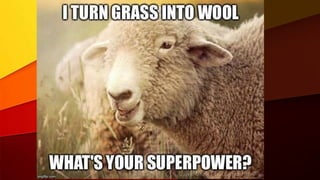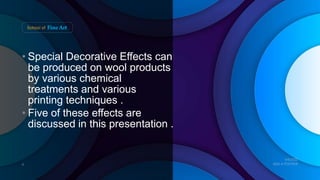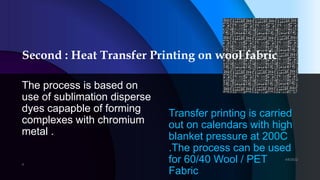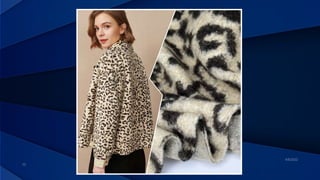Decorative effects on wool fabrics.pdf
- 1. Decorative Effects on Wool Fabrics Dr Adel A.Halim Ex Director Intl Wool Secretariat
- 3. Wool Fibers Wool Quality depends mainly on the fiber diameter; the smaller the diameter , the finer and more valuable the fiber . Fine qualities come mostly from Marino sheep which can be spun into finer yarn counts.
- 4. Wool Fibers Course wool comes from cross breed sheep and they are spun into coarser yarn counts
- 5. Marino Wool mainly comes from Australia and South Africa . It has a fiber micron of range from superfine 16 micron up to fine 25 micron Cross breed wool mainly comes from New Zealand which has fiber micron range from 25 micron up to 40 micron ( Micron = 1/1000 millimeter = 1/million meters
- 6. • Special Decorative Effects can be produced on wool products by various chemical treatments and various printing techniques . • Five of these effects are discussed in this presentation .
- 7. First The luster Mohair like effect on the wool fabric The principle of this process is to increase smoothness of the wool fiber surface by chemical treatment which attack fiber surface scale Attacking surface scales result in smooth fiber surface and hence increase light reflectance giving luster effect
- 9. Second : Heat Transfer Printing on wool fabric The process is based on use of sublimation disperse dyes capapble of forming complexes with chromium metal . Transfer printing is carried out on calendars with high blanket pressure at 200C .The process can be used for 60/40 Wool / PET Fabric
- 11. Third : Burn Out Effect or Devore Effect The process is done on wool/polyester blended fabric. The effect is produced by printing the fabric with a thickened solution of sodium hydroxide which destroys the wool in the print areas producing the effect
- 13. Fourth : Panel Printing (direct and resist printing on knitwear garments ) Direct & Resist printing on Knitwear garments. There are 3 variations of the process: Direct, resist and dye/resist printing The printing technique is simple and based on cold batch technology
- 14. Fourth : Panel Printing (direct and resist printing on knitwear garments ) Printing of garment panel with paste containing selective reactive dyes and chemicals which facilitate cold fixation Garment after printing is stored cold up to overnight . If ecru prints are required on dark grounds they can be reduced by incorporating dye resist agent (Sandospace R in printing paste prior to garment dyeing
- 15. Fifth : Sculpture effects through Panel Printing of Knitwear garments The basic principle of the process to print the design with thick solution of suitable shrink -proofing agent ( Anti-felt agent) onto unfinished garement followed by scouring and milling Effect is produced due to resistance of printed areas to milling action so the sculpture appearance is produced. The process exploits the natural property of wool to felt under action of moisture and pressure during milling . Felting is produced in wool due to presence of scales an wool fibers surface.
- 17. Thank you! Dr Adel Abdel Halim Phone: 0100 400 4287 Email: dradel43@Hotmail.com
















